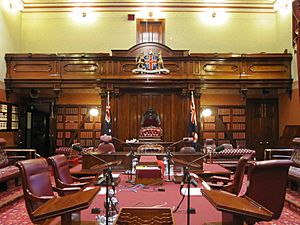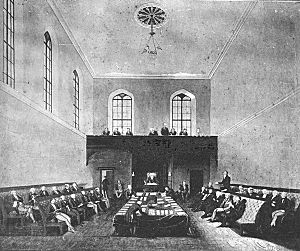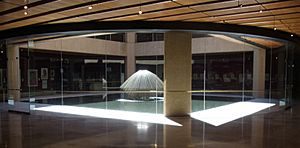Parliament House, Sydney facts for kids
Quick facts for kids Parliament House |
|
|---|---|

Parliament of New South Wales
|
|
| General information | |
| Architectural style |
|
| Address | 6 Macquarie Street, Sydney NSW |
| Country | Australia |
| Owner | The Crown in the Right of the State of New South Wales |
| Official name | Parliament House; Parliament of New South Wales; Parliamentary Precincts; Rum Hospital |
| Type | state heritage (built) |
| Criteria | a., b., c., d., f., g. |
| Designated | 19 April 2002 |
| Reference no. | 1615 |
| Type | Parliament House |
| Category | Government and Administration |
The Parliament House in Sydney is a special group of buildings. It is where the Parliament of the state of New South Wales, Australia, meets to make laws. The building is on the east side of Macquarie Street in Sydney.
The front of the building has a two-storey Georgian style. This is the oldest public building in Sydney. On each side, there are two newer parts built in a Neo-gothic style. These parts hold the rooms where the Parliament meets. All these buildings are connected to a 12-storey building at the back, which faces the Domain.
Unlike other Parliament buildings in Australia, Sydney's Parliament House was first built as a public hospital. It is not as grand in its looks. There have been many ideas to build a new Parliament House, but none have happened. This important building was added to the New South Wales State Heritage Register on 19 April 2002. It is also known as the Parliament of New South Wales and the Rum Hospital.
Contents
How Parliament House is Set Up
The main entrances are in a two-storey building with a front porch. On the ground floor, you will find two entrance halls. Between these halls is the Parkes Room. This room is used for small meetings and events. The rooms upstairs are used by Hansard, which records everything said in Parliament.
The Legislative Assembly
To the north of the main entrance building is the room for the Legislative Assembly. This is the "lower house" of Parliament. The room is decorated in green. This colour choice follows the tradition of the United Kingdom House of Commons.
At one end of the room is the Speaker's chair. The Speaker is like the referee for debates. In front of the chair is a table holding the mace, a symbol of authority. Members of the government sit to the Speaker's right. Members of the opposition sit to the left. There are special areas for the press, Hansard, guests, and the public to watch the meetings.
The Legislative Council
At the other end of the entrance building is the Legislative Council chamber. This is the "upper house." This room is decorated in red, like the House of Lords in the UK.
This chamber has a special chair for the Monarch or her representative, the Governor. There is also a chair for the President of the Council. Both chairs are made from red cedar. The table in front of the chairs is also made from red cedar. The wall behind the chairs has bookshelves filled with Hansard records. The room also has busts (sculptures of heads and shoulders) of important past members.
Just like in the lower house, government members sit on the President's right. Opposition members sit on the left.
Other Areas
Behind the main entrance building is the Jubilee Room. This room is used for committee meetings and public events. In this area, which is open to everyone, you will also find the Fountain Court. It is an exhibition space with a fountain designed by Robert Woodward.
Below the Fountain Court is a small theatre with 166 seats. Above it is a roof garden used for events. These areas, built in the 1970s, connect the older buildings to a 12-storey building at the back. This taller building has offices for members of Parliament and staff. It also has meeting rooms, dining areas, a fitness area, and parking. The building even has a special power unit. It helps power Sydney Hospital and the State Library of New South Wales too.
A Look at Parliament House History
The oldest part of Parliament House was built as the north wing of Governor Macquarie's "Rum Hospital." Governor Macquarie set aside the land for Macquarie Street in 1810. The British government did not provide money for the hospital. So, a deal was made to use convict workers. In return, the builders got special rights to import rum. The hospital, made of three two-storey buildings, was finished in 1816.
The north wing was originally the Chief Surgeon's living area. But it was also used as law courts for a time. When the Legislative Council was formed in 1824, it did not have a permanent home. It met in places like the old Government House. In 1829, the Council grew to 15 members. They started meeting in a downstairs room of the Surgeon's quarters.
From 1831 to 1836, the Clerk of the Council was also in charge of Australia's first museum. It was a small collection of natural history items. This collection later grew into the Australian Museum.
Growing Pains and New Chambers
The Legislative Council grew even larger in 1843, to 36 members. The old room was too small. So, a new chamber was added to the north of the building. This new room became the home of the Legislative Assembly. This happened when a two-house system (called bicameral) was started in 1856.
The Legislative Council moved to a special building made of iron. This building was made in Scotland and shipped to Melbourne. It was bought for £1,835 and then moved to Sydney. It was set up at the southern end of the original hospital building. The new Parliament officially opened on 22 May 1856, even though the building was not fully finished.
The new iron chamber had some issues. The walls and curved iron roof caused problems with sound, light, and air. The roof was replaced in 1959. The front of the building was moved closer to the street in 1892–93. The southern wall started to fall apart in the 1920s. Wooden supports were added to hold up the ceiling. The southern wall had to be completely rebuilt in the 1930s.
Over time, a dining room was built behind the hospital building. The Parliamentary Library also grew and moved into the original Legislative Council chamber. The Jubilee Room was built in 1906 as a reading room for the library.
Ideas for Rebuilding
For many years, there were plans to rebuild or extend Parliament House.
- In 1861, a design for a new building in the Gothic Revival style was chosen, but it was never built.
- In 1888, a foundation stone was laid for a large new building. It would have had entrances on Hunter Street and facing the Domain.
- In 1897, another design was made by Walter Liberty Vernon. This plan would have placed the building further back from Macquarie Street.
- In 1907, a new neoclassical front was planned. This also included making Macquarie Street wider. But the government did not give enough money.
- In 1935, there was a proposal to knock down the old Parliament House, Sydney Hospital, and Sydney Mint. New buildings would be put in their place. This plan was put off because of the Great Depression.
- In 1964, a plan suggested moving Sydney Hospital to build a huge new Parliament House. The older buildings like the Mint and Hyde Park Barracks would be fixed up.
- In 1970, new plans for Parliament House started. The old building was not in good shape. Many members had to share small rooms.
- In 1972, the plans were presented to Parliament. It was decided that the new building had to be built within the existing land. Also, Parliament had to keep working during construction. So, the work was done in stages. A temporary building was even put on the parliamentary tennis court.
- In 1975, Premier Tom Lewis asked for an auditorium and a media centre to be added. The first construction work began, including moving an old building called Richmond Villa to a new location.
- By 1979, the first part of the new building facing the Domain was finished. The second stage connected this new part to the old heritage buildings on Macquarie Street. The Fountain Court, with its fountain by Robert Woodward, was finished in 1983. The last part of the rebuilding was completed in 1985. The inside of the Legislative Council and Legislative Assembly chambers were made to look like they did in 1892. The old Surgeon's Quarters and the former Parliamentary Library were also restored.
Artworks at Parliament House
Many artworks at Parliament House were borrowed from the Art Gallery of New South Wales. When the building was rebuilt, money was set aside to buy new art. Four women artists were asked to create works for important areas.
- In the dining area, there are two tapestries by Fay Bottrell.
- In the main lift lobby, a tapestry by Margaret Grafton shows the coat of arms of New South Wales.
- Heather Dorrough created a series of wall hangings for the staff dining room.
- A painting of Parliament House by Kitzpatrick hangs in the Fountain Court.
Rooms for members, ministers, and staff have framed prints or photos by Australian artists. Some paintings were also bought, including a famous portrait of Patrick White by Brett Whiteley.
Why Parliament House is Special
As of 2012, Parliament House is very important for its history and social value. It has played a key role in Australia's history. It started as an early symbol of colonial government. Then it became the first Parliament House for New South Wales. It is also linked to the idea of Federation, when the Australian colonies joined together.
Parliament House and the Mint Museum are the only two parts left of the original General Hospital. This hospital started being built in 1811. It was part of Governor Macquarie's big building plan for the colony. Since London would not give money, Governor Macquarie made a deal. Three businessmen built the hospital in exchange for special rights to import rum for three years. That is why it was called "The Rum Hospital."
The north wing of the hospital was taken over in 1829. It became the first NSW Parliament House because it was the biggest public building at the time. It was the first Parliament in Australia. Parliament House has also been important for Australia's history because two major meetings were held there. These meetings discussed the idea of Federation and helped write the Australian Constitution in the 1890s. Parliament House is also connected to many important social and political figures from the past.
The Parliament buildings include the original old Georgian building (the Rum Hospital), finished in 1816. They also include later additions. A new chamber was built in 1842 for the Legislative Council. The Legislative Council's current chamber is a special building made of cast-iron. It was made in Glasgow, Scotland, and first sent to Melbourne. Then it was sent to Sydney to be one of the two parliamentary chambers. It is still used by the government today. The middle part of the hospital was knocked down in 1879. The Sydney Hospital building was built in its place and finished in 1894.
As part of Sydney's oldest group of public buildings, Parliament House has been at the centre of the history of New South Wales. It continues to be a key part of the state's history as the seat of government today.
Parliament House, Sydney, was added to the New South Wales State Heritage Register on 19 April 2002. This means it meets certain important standards:
- It shows the path of history in New South Wales.
Parliament House has played a long and central role in the state's affairs. It was first Australia's permanent hospital. Then it became the Parliament of New South Wales. It shows how the political needs of the colony and NSW changed over time.
- It is linked to important people or groups in New South Wales history.
Many important historical events have happened at Parliament House. The Parliament of New South Wales was the first law-making body in Australia. It was key in the push for self-government in 1856. It also played a big part in the move to Federation. It held two meetings about Federation and helped write the Australian Constitution in the 1890s.
- It shows great design or technical skill.
The building is a good example of early colonial architecture. It was finished in 1816. It was part of Governor Macquarie's plans to build important public buildings and shape the town.
- It is important to a community or group for social or cultural reasons.
In 1792, Governor Phillip set aside the land for the Botanic Gardens, Domain, Hyde Park, and Macquarie Street for government use. Macquarie Street itself was created in 1810 by Governor Macquarie.
Also, the Parliament of NSW is important to the public. It has helped shape the society we live in today. For example, Parliament played a big role in getting women the right to vote. New South Wales gave women the vote in July 1902.
- It has rare or unusual aspects of New South Wales history.
The building was part of Australia's first permanent hospital. It also held the first Parliament in Australia. It is the oldest public building still standing in the City of Sydney. It is rare because it has continuously been used as a working government building.
- It shows the main features of a type of historical place.
Parliament House is a great example of old colonial Georgian architecture in New South Wales.
Images for kids















